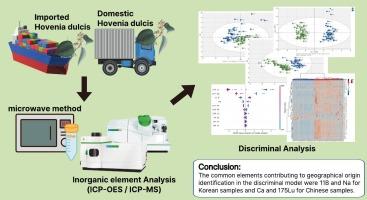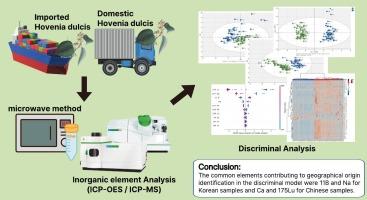利用电感耦合等离子体光谱和多元统计分析方法对韩国和中国黄花菊的地理来源进行了分析
IF 9.8
1区 农林科学
Q1 CHEMISTRY, APPLIED
引用次数: 0
摘要
韩国人常用的宿醉药“牛蒡子”的果实以韩国和中国产品的形式销售。为了保护国内生产者,确保标签的准确性,保护消费者,本研究采用电感耦合等离子体发射光谱和质谱法对无机元素进行分析,以区分原产地。正交偏最小二乘判别分析显示模型质量较高(R2 = 0.956,Q2 = 0.883)。25个因素在投影(VIP)值中具有可变重要性≥1,接受者工作特征分析证实准确率为100% %。系数图显示,Ca(- 0.453081)、103Rh(- 0.222397)、175Lu(- 0.2084)在中国人中显著,11B(0.137669)和88Sr(0.0954821)在韩国人中显著。线性判别分析显示,组间距离为19,表明判别性强。研究结果强调,基于icp的元素分析与化学计量学和机器学习是一种强大的工具,可用于验证桃属植物的来源,具有优于传统视觉方法的优势,并支持监管监测、标签准确性和消费者保护。本文章由计算机程序翻译,如有差异,请以英文原文为准。


Determination of geographical origin of Hovenia dulcis found in Korea and China via inorganic element analysis using inductively coupled plasma spectroscopy and multivariate statistical analysis
The fruit of Hovenia dulcis, a popular Korean hangover remedy, is marketed as Korean and Chinese products. To protect domestic producers, ensure accurate labeling, and safeguard consumers, this study discriminated origin through inorganic element analysis using inductively coupled plasma-optical emission spectroscopy and mass spectrometry. Orthogonal partial least squares-discriminant analysis showed high model quality (R2 = 0.956, Q2 = 0.883). Twenty-five elements had variable importance in projection (VIP) values ≥1, and receiver operating characteristic analysis confirmed 100 % accuracy. Coefficient plots revealed Ca (−0.453081), 103Rh (−0.222397), 175Lu (−0.2084) significant for Chinese, while 11B (0.137669) and 88Sr (0.0954821) were significant for Korean. Linear discriminant analysis showed intergroup distance of 19, indicating strong discrimination. Findings highlight ICP-based elemental profiling with chemometrics and machine learning as a robust tool for authenticating H. dulcis origin, offering advantages over traditional visual methods and supporting regulatory monitoring, labeling accuracy, and consumer protection.
求助全文
通过发布文献求助,成功后即可免费获取论文全文。
去求助
来源期刊

Food Chemistry
工程技术-食品科技
CiteScore
16.30
自引率
10.20%
发文量
3130
审稿时长
122 days
期刊介绍:
Food Chemistry publishes original research papers dealing with the advancement of the chemistry and biochemistry of foods or the analytical methods/ approach used. All papers should focus on the novelty of the research carried out.
 求助内容:
求助内容: 应助结果提醒方式:
应助结果提醒方式:


